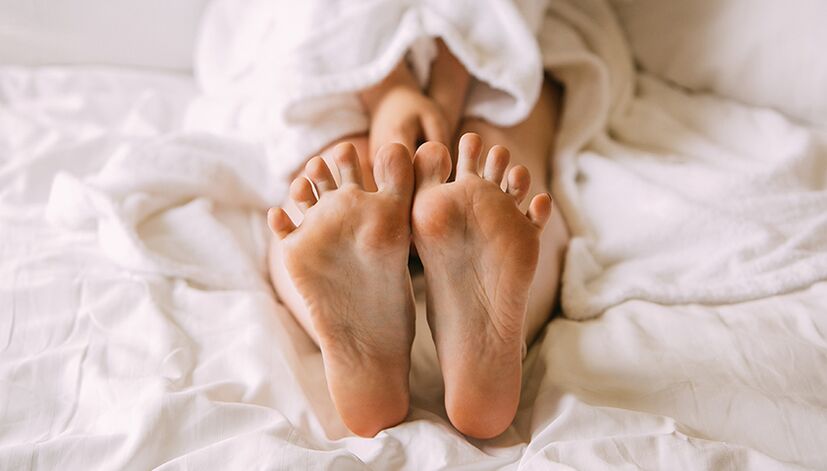
Dermatophytosis is an infectious disease caused by pathogenic or opportunistic fungi. When suffering from fungal disease, the skin on the feet peels off and is very itchy. In severe cases, it will turn red and swollen.
Definition of disease
Athlete's foot or athlete's foot is an infectious disease caused by dermatophyte mold. A total of 43 species of tinea pedis are known, 30 of which lead to athlete's foot. The most common fungi are Trichophyton rubrum (90%), Trichophyton mentagrophytes and, less commonly, Epidermophyton. Less common athlete's foot is caused by fungi of the genus Candida and molds Scytalidium dimidiatum and Scytalidium hyalinum.
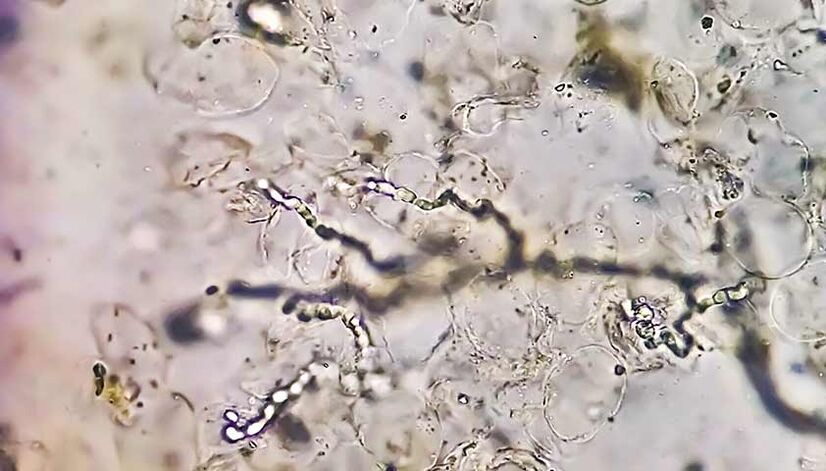
All dermatophytes have keratolytic activity: they can dissolve keratin, the fibrous protein that forms the upper part of human and animal skin. Damaged skin.
Once on the skin, the fungus will target the most vulnerable places - the junctions between the cells of the epidermis. There they penetrate inside and begin to actively grow. However, fungi rarely penetrate deeper than the granular layer of the skin. Usually they are limited to the upper, keratinized tissues.
Incidence of athlete's foot
Fungal skin diseases, including athlete's foot, are found in all countries around the world. The rate of these diseases in the structure of all dermatological diseases reaches 37–40%.
At the same time, mycosis occurs most often - in about 30% of cases.
According to dermatologists, up to 20% of the adult population suffers from athlete's foot. Pathology is found twice as often in men.
Among people over 70 years old, foot fungus is found in almost every second patient - this is explained by the fact that older people often suffer from chronic diseases associated with metabolic disorders, as well as diseasesvascular conditions, such as varicose veins.
Athlete's foot infections often occur in families - through direct contact with the skin of an infected person. There are also cases of infection when sharing clothes, shoes and household items.
The infection often affects both feet at the same time and partially spreads to the nail plates. If left untreated, the disease can also affect the skin on the palms of the hands - usually on the working hands. This condition is called two-legged-one-armed syndrome.
Causes of athlete's foot
Most often, fungal diseases of the feet are caused by dermatophyte fungi - Trichophyton rubrum, Trichophyton mentagrophytes and Epidermophyton floccosum. Less often, this disease is caused by fungi of the genus Candida (Candida) and molds (Scytalidium dimidiatum, Scytalidium hyalinum).
According to some studies, the proportion of dermatological cells in the structure of the causative agent of athlete's foot is gradually decreasing. Candida fungus appears.
Risk factors for developing athlete's foot:
- violation of personal hygiene;
- shoe sharing (e. g. , in bowling alleys, ski and ski rental shops);
- Visit public baths, swimming pools, beaches;
- climatic features: the risk of disease is higher in countries with subtropical and tropical climates - this is due to increased humidity and ambient temperature;
- often wear closed, tight shoes (this happens in soldiers, miners, workers in the textile and metallurgical industries);
- frequent toe injuries due to flat feet, corns, and calluses;
- failure to comply with hygiene rules during pedicure;
- Blood supply to the legs is impaired;
- immunocompromised conditions, including HIV;
- chronic skin disease;
- fat;
- diabetes;
- chronic venous insufficiency;
- taking certain medications (systemic glucocorticosteroids).
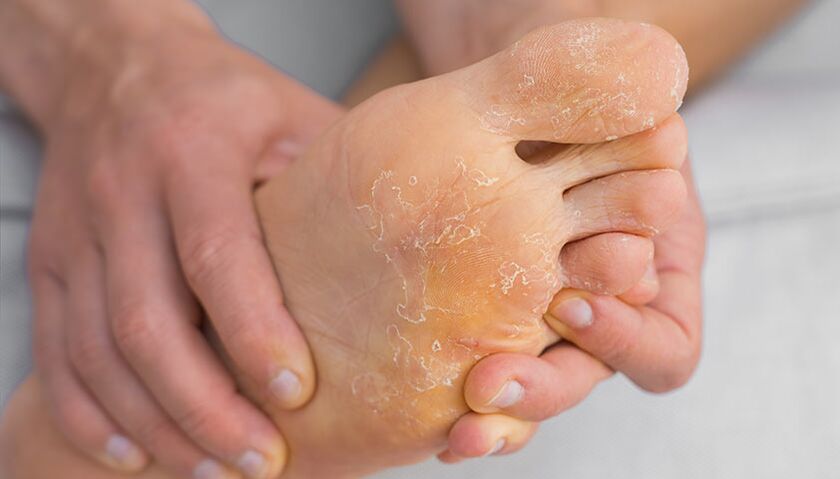
Symptoms of athlete's foot
Symptoms of athlete's foot, as well as the features of treatment of the disease depend on its clinical form.
The scaly (scaly-hyperkeratogenic) form of athlete's foot
In most cases, the causative agent of athlete's foot is Trichophyton rubrum.
In the early stages of the disease, the patient feels uncomfortable because of moderate peeling of the skin between the fingers - the scales on the skin are many, thin and silver in color. Then, as the disease spreads to the lateral and dorsal sides of the foot, a characteristic inflammation appears and the skin in the affected areas thickens. Over time, the patient develops onychomycosis - onychomycosis.
Interdigital (interdigital) mycosis of the feet
This form often develops based on excessive foot sweating. It affects the spaces between the fingers and is accompanied by redness, swelling and peeling (tender and loose skin). Erosion and cracks often form. Many patients report itching, burning, and pain.
Often, simultaneous infection of the skin of the feet occurs with dermatophyte fungi (usually Trichophyton mentagrophytes var. interdigitale) and Staphylococcus aureus bacteria.
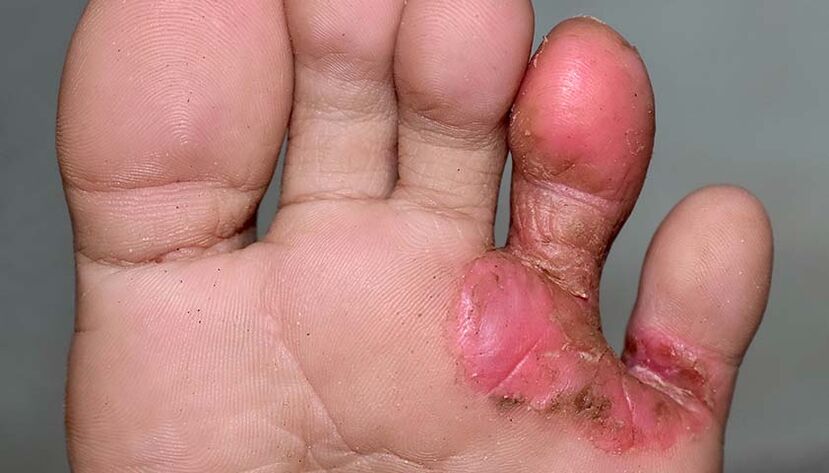
Dyshidrotic form of athlete's foot
As a rule, the causative agent of this form of mycosis of the feet is Epidermophyton floccosum (exfoliation of the epidermis).
As a rule, the form of athlete's foot is more severe and is accompanied by itching and pain. Blisters are thick coverings on the skin. Fusing, they form large multi-chambered blisters, which upon opening turn into moist pink-red ulcers and then into brown crusts.
The disease is difficult to treat and often recurs.
A characteristic feature of the dyshidrotic form is damage to the arch of the foot, the folds between the fingers and the skin of the fingers. This process can then spread to the heel, the underside of the foot and even to the skin below the ankle.
If a bacterial infection occurs, the patient may develop a fever and regional lymph nodes will become swollen. Swelling of the foot appears and the skin on it becomes wet. Severe pain makes it difficult for the patient to walk.
Exudative-dyshidrotic form of athlete's foot
Typically, the exudative-dyshidrotic form of athlete's foot is caused by the fungus Trichophyton rubrum (red trichophyton).
The skin between the fingers is affected first. This process then spreads to the soleus, dorsal and lateral surfaces of the foot as well as the nail plates. Blisters and erosions appear on the skin, which is then covered with a crust. The skin becomes wet and may fester.
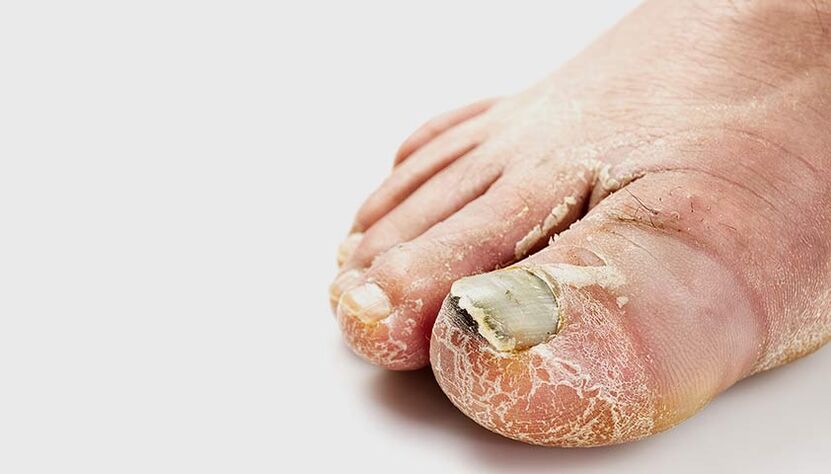
The form of athlete's foot has been removed
The deleted form was determined by several researchers. It is believed that it occurs a few days after a fungal infection.
The skin in the digital folds begins to peel off. There may also be mild peeling on the soles and sides of the feet. Patients can ignore unpleasant symptoms but still infect others.
Acute form of athlete's foot
The acute form of athlete's foot results from exacerbation of the necrotic or interdigital (interdigital) form.
The disease begins acutely: a large number of blisters appear on the skin of the feet and then the feet. Skin swells. Then papules form on the hands and lower parts of the forearms.
After the blisters open, ulcers appear, surrounded by loose pieces of skin. They fuse, turning into widely oozing surfaces, often containing pus.
The disease is often accompanied by fever, deterioration of the patient's general condition, and sharp pain in the affected hands and feet. The lymph nodes in the groin and femur swell and become painful.
The vesicular (inflammatory) form of athlete's foot
The form of athlete's foot is often identified by foreign authors and is often determined to be acute. It can develop from a chronic form of intertechnical dermatosis.
As a rule, the causative agent of vesicular disease is the dermatophyte Trichophyton rubrum.
Main symptoms: severe itching, skin rash, mainly localized on the soles of the feet, the base and edges of the fingers, and the back of the feet. Swollen areas with blisters on the surface may appear. The bubbles can merge or remain unchanged for a long time - if the tire (upper part) is thick enough.
Usually the nail plates also participate in this process - onychomycosis develops.
Ulcerative form of athlete's foot
Ulcerative form (in foreign literature called deep) is one of the complications of athlete's foot, caused by additional bacterial infection.
On the soles of the feet there are deep ulcers with spreading pus. The patient feels severe pain and as a result has difficulty walking.
Complications of athlete's foot
Cracks and ulcers in the skin that appear at the site of a fungal infection are the gateway to a bacterial infection. However, treatment of such infections is more difficult - this is explained by the fact that fungi secrete special substances that increase bacteria's resistance to drugs.
The most common complications of athlete's foot:
- allergic dermatitis of infectious and drug origin;
- pyoderma - pustular skin disease (cellulitis, lymphangitis, purulent inflammation, osteomyelitis of the metatarsal bones), which can lead to deep, long-term skin wounds;
- plantar warts;
- Bacterial eczema is a chronic inflammatory disease in which the skin is itchy, red, and develops liquid blisters;
- decreased general immunity and impaired microcirculation in the lower extremities (often develops in patients with diabetes and varicose veins);
- spread the disease to the skin of the hands and nails;
- Quality of life declines: in the acute form of mycosis, it is difficult to put on shoes and lymphadenitis leads to fever and poor health.
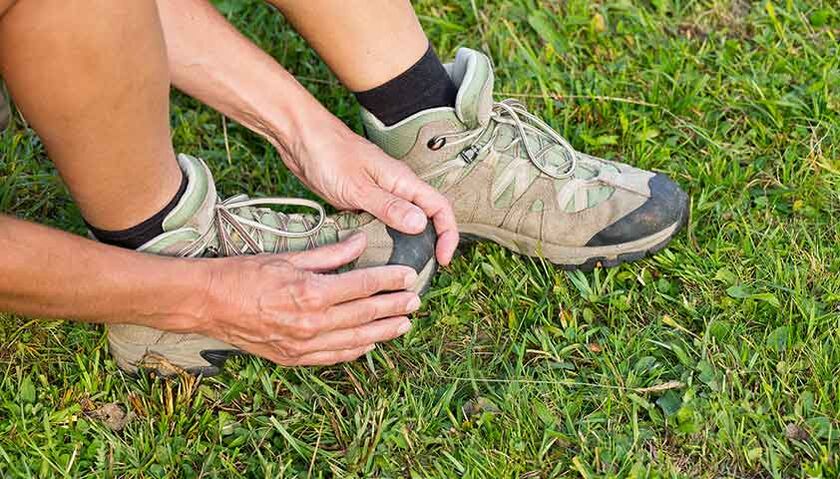
Diagnosis of athlete's foot
A dermatologist-mycologist deals with the diagnosis and treatment of fungal diseases of the feet.
During the examination, the doctor will evaluate the condition of the patient's nails, skin, mucous membranes and hair. He will perform dermoscopy - examining the skin under magnification. Along with the examination, the specialist will collect medical history and ask the patient about lifestyle, nutritional quality, living habits and family care procedures.
If you suspect athlete's foot, your doctor will order tests.
Examination of skin scrapings will rule out or confirm a fungal infection.
The doctor may also refer the patient for microscopic examination and culture.
Sowing, or cultivation, allows you to get more accurate information about the pathogen, although it takes longer - usually a month.
Diabetes can worsen athlete's foot and lead to serious complications. Complex studies can rule out or confirm this diagnosis.
A complete blood count helps evaluate the patient's general condition.
A clinical blood test is a blood test that allows you to assess your general health, identify inflammation, bacterial, viral and fungal infections, and can also help diagnose anemia, otherdiseases of hematopoietic organs, allergic reactions and autoimmune diseases.
In addition, before recommending treatment with antifungal drugs, the doctor may prescribe the patient a biochemical blood test - this study will determine the level of bilirubin and liver enzymes ALT and AST. Such information will help the doctor choose the dosage of the drug and minimize the risk of side effects.
Treatment of athlete's foot
Treatment of athlete's foot is carried out in two stages.
In the first stageIf there is acute inflammation, topical medications are used: ammonium bitumen sulfonate solution, substances with antiseptic properties (Castellani liquid, brilliant green 1% aqueous solution). Then pastes and ointments containing antifungal drugs and glucocorticosteroids are prescribed.
In case of excessive crying (in the acute phase) and additional secondary infection, anti-inflammatory solutions are used in the form of topical medications, as well as combined antibacterial drugs in the form of creams and solutions.
The basis of therapy is the use of antifungal drugs - antifungal drugs.
In the main stageTreatment uses antifungal medications designed to kill the fungus that causes the disease. Usually, these drugs are produced in the form of ointments, creams or solutions.
If the patient experiences severe itching, a dermatologist may prescribe antihistamines. They are usually taken for 10-15 days until the unpleasant symptoms disappear completely.
When nails are damaged, antifungal agents are used - they are applied directly to the nail plate and nail folds. In this case, the drug concentrates on the surface of the nail and does not penetrate into the blood, eliminating the risk of side effects.
If topical medications are not effective, systemic antifungal medications will be prescribed.
The treatment regimen and dosage of the drug are determined by the doctor. During treatment, it is necessary to see a podiatrist at least once a month.
Prognosis and prevention
If you consult a doctor in time, the prognosis of fungal diseases of the feet is favorable: most patients treated with antifungal drugs will recover from the disease forever.
To prevent fungal diseases, you need to protect your feet and hands from factors that cause irritation and injury, and strengthen your immune system.
Measures to prevent nail fungus:
- Change your socks every day or more often if your feet are sweaty or wet;
- Dry or dry shoes after wearing;
- Use an anti-fungal UV shoe dryer;
- Do not wear shared sandals when visiting;
- Do not try on shoes in the store barefoot;
- Use a personal towel to wipe your feet;
- Use separate tools for nail care (tweezers, files);
- wear shoes in swimming pools or saunas;
- monitor the variety of your diet;
- Avoid stressful situations.
Frequently asked questions
How to treat foot fungus?
To treat foot fungus, people often use antifungal medications, available in cream, ointment, and solution form. A dermatologist should choose the most effective drug and determine its dosage.
Why do my feet itch?
One of the causes of itchy feet is athlete's foot, an infectious disease caused by dermatophyte mold.



























